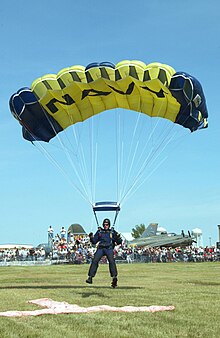
Back Valskerm Afrikaans مظلة هبوط Arabic Paracaíes AST Paraşüt Azerbaijani Парашут Byelorussian Парашут Bulgarian पैराशूट Bihari Parasut BJN প্যারাশুট Bengali/Bangla Harz-lamm Breton



A parachute uses drag to slow something moving in air. It is often an umbrella shaped device on which people or things can float slowly and safely down to the ground from a great height, such as an aircraft.[1]
The word parachute comes from the French words parer meaning to protect and chute meaning fall carefully down making sure you are safe. Drogue parachutes are used to aid horizontal deceleration of a vehicle (a fixed-wing aircraft, or a drag racer), or to provide stability (tandem free-fall, or space shuttle after touchdown).
Parachutes are used in a sport called skydiving. Paratroopers are soldiers who attack by jumping from an airplane.
The word "parachute" comes from "para", meaning "against" or "counter" in Ancient Greek, and "chute", the French word for "fall". In many other languages, the word refers to "falling-screen", such as German Fallschirm. Some modern parachutes are classified as semi-rigid wings, which are maneuverable and can make a controlled descent to break on impact with the ground.
The inventor Leonardo Da Vinci sketched a parachute in his Codex Atlanticus (fol. 381v), in about 1485. Leonardo's canopy was held open by a square wooden frame. The feasibility of Leonardo's pyramidal design was successfully tested in 2000 by the Briton Adrian Nicholas and again in 2008 by another skydiver. According to the historian of technology Lynn White, these conical and pyramidal designs, much more elaborate than early artistic jumps with rigid parasols in Asia, mark "the origin of the parachute as we know it".
- ↑ Wragg, David W. (1973). A Dictionary of Aviation (first ed.). Osprey. p. 209. ISBN 9780850451634.